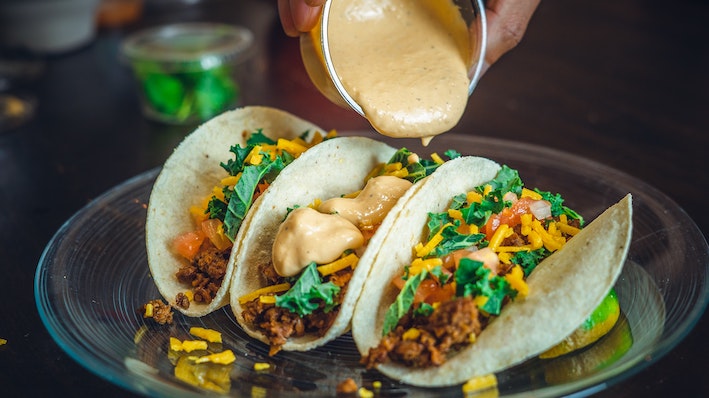Taco Day: All About this Mexican Street Food

October 4th marks National Taco Day in the US. A staple of Mexican street food, cooks can make this dish in a variety of different ways with a myriad of different ingredients. In today’s blog, we’re diving into the history behind this perfect hand-food. Plus, the plethora of variations it comes in.
What is a Taco?
A taco is a traditional Mexican dish. It consists of a small hand-sized corn or wheat tortilla topped with a filling. To eat, the tortilla folds arounds the filling. Eaters can use their hands. The filling includes:
- Beef
- Pork
- Chicken
- Seafood
- Beans
- Vegetables
- Cheese
Additionally, other garnishes include condiments such as:
- Salsa
- Guacamole
- Sour Cream
- Queso
And, other vegetables such as:
- Lettuce
- Onion
- Tomatoes
- Chiles
The taco is similar to other antojitos (Mexican street food) such as: the burrito, which is larger and rolled rather than folded; the taquitos which are rolled and fried; and, tostadas which is when the tortilla is fried before filling.

Its History
The origin of the taco is not precisely known. In fact, the word is a Mexican innovation as in the Spanish language, in other contexts, it means “wedge; plug; short, stocky person; or short, thick piece of wood”.
This is because the taco predates the arrival of the Spanish in Mexico. There is evidence that the indigenous people living there traditionally ate the dish filled with small fish. In fact, this leads to the proposal that the word actually derives for the Nahuatl “tlacho” meaning “half” or “in the middle”.
Traditional and Non-Traditional Variations
As we mentioned, we can prepare a taco in a number of different ways. First, let’s start with the traditional variations.
Traditional
- Al Pastor. “Shepherd Style” these tortillas fill with thin pork steaks seasoned with adobo seasoning. These steaks flame-broil rotisserie style.
- De Asador. This dish is composed of any of the following: carne asada; tripe, grilled until crisp; and, chorizo asado. Each type serves with two overlapped small tortillas garnished with guacamole, salsa, onions, and cilantro,
- De Cabeza. “Head Tacos”. A flat punctured metal plate (from which steam emerges) cooks the head of the cow. Thus including: cabeza, a serving of the muscles of the head; sesos “brains”; lengua “tongue”; cachete “cheeks”; trompa “lips”; and ojo “eye”. The tortillas are served warm, in pairs, and also include salsa, onion and cilantro.
- De Camarones. Translating to “shrimp”, they originate in Baja California, in Mexico. Grilled of fried shrimp find themselves paired with lettuce, pico de gallo, avocado, and sour cream. This fills a corn or flour tortilla.

- De Cazo. First, a metal bowl filled with lard serves as a deep-fryer. In it meats such as tripe, tender beef cuts, and oesophagus cooks. The name translates to “bucket”.
- De Lengua. This “beef tongue” filling has its meat cooked in water with onions, garlic, and bay leaves for several hours until soft and tender. Then, it’s sliced and sautéed with oil. It is said that only real taquerias offer this dish.
- De Pescado. Again, originating in Baja California this dish is similar to the “shrimp” variation but with grilled or fried fish instead.
- Sudados. This “sweaty” tortilla fills with a spicy meat mixture and is placed in a basket covered with cloth. Thus, keeping the dish warm and trapping steam (“sweat”) which softens them.
As an accompaniment to the dish, sliced red radishes, lime slices, salt, and pickled or grilled chilies come with the taco.
Non-Traditional
As the taco popularised around the world, other countries made their own variation of the dish.
- Hard Shell. This crispy shell is a tradition developed int he United States. While the filling is similar, the corn tortilla is crisp-fried. Thus, making it harder for it to maintain its shape.
- Native American. Also known as Navajo tacos, this dish uses fry bread instead of tortillas. Tradition indicates they came into play in the 1860s when the government forced the tribe to relocate from their homeland in Arizona.
And there you have it — the many varieties of the diverse taco! Which will you be eating today?